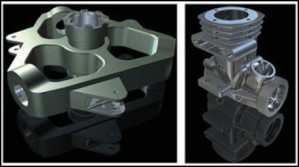Autodesk released its entry into the MCAD direct editing sweepstakes in June 2007 with the preview release of AutoCAD Inventor LT. This article from the archives of Engineering Automation Report describes the initial product.
By Randall S. Newton
Engineering Automation Report, June 2007—Autodesk this month launched a free “technology preview” version of Autodesk Inventor LT. The target audience is those who work with 3D model data but do not necessarily create it. This placed the new product in the category of 3D design editing, where several companies (including Adobe) are already trying to build a market. The product is free during its preview period, but will eventually be sold for around $1,000.
The Product

Inventor LT is a streamlined version of Inventor, which Autodesk claims is the world’s top-selling 3D mechanical design software. (A close analysis of units sold leads some to dispute that claim and give the top-selling award to SolidWorks instead.) The feature set focuses on users who need to edit and share 3D models—and sometimes create them. Along with the free download, users are encouraged to download a separate set of “translator add-ins” that allow Inventor LT to import/export in Parasolid and GRANITE (from PTC), and to import UGS NX and Pro/ENGINEER files. This same download can be used with Autodesk Inventor. And, of course, Inventor LT also imports/exports in Autodesk’s DWF 2D/3D publishing format and good ol’ DWG and DXF. Other supported formats are STEP, IGES, SAT, STL, and JT.
Key capabilities from full Inventor not found in Inventor LT include 3D assembly modeling, many specialized tools such as for sheet metal design and dynamic simulation, an API, and a copy of Autodesk Vault. If a user attempts to open an assembly in Inventor LT, the product prompts the user to open the assembly in Inventor View, a free viewer included with Inventor LT that offers view, measure, and plot capabilities. Inventor LT also ships with photorealistic rendering, an important feature for its intended market of users who will primarily use 3D data created by others.
Inventor LT Technology Preview is currently only available in English for download in the United States and Canada. Inventor 2008 and Inventor LT cannot co-exist on the same computer; Inventor LT can be installed on computers that are already running Inventor 11 or earlier.
The Launch
Inventor LT is hosted on Autodesk Labs. The site started as a unbranded, renegade outreach by Autodesk developers to get interesting new technologies into user hands much earlier than possible in traditional development cycles. It even featured a Labrador Retriever as a site mascot. The site has since been taken over by marketing—nicely, I am told by developers—and is now a major vehicle for Autodesk to generate interest around new products. The model was perfected with Autodesk Impression, a non-photorealistic rendering tool for AutoCAD. Four separate preview versions of Impression were posted over the course of a year, as Autodesk added new features in response to user comment. Impression is now a “graduate” of Labs, joining the Autodesk line of products for sale. Other companies using “labs” sites to promote new technology include Google, Adobe, and Microsoft.
The Market
My first impression is that Inventor LT is a quick-strike response to the sudden rise of interest in the ability to directly edit 3D models without using the original authoring CAD tool. While any of the current crop of history-free CAD modelers can do this to some degree, they are also CAD and thus suspect by those who only want to edit or enhance 3D models. By definition, we have to include new Inventor LT in this category.
Two product launches in 2007 bring urgency to Autodesk’s desire to have a horse in the 3D model editing race. The first was the recent launch of SpaceClaim Professional, a history-free 3D editing tool from SpaceClaim, Inc. with an interface that looks more like an stylized Adobe Illustrator than a CAD product. There are other products targeting this new sub-genre as well, but SpaceClaim has made the most noise and attracted the most attention, with one very big exception: Adobe Acrobat 3D.
It took Autodesk a year to move Impression from debut on Autodesk Labs to release as a product. But they were starting from scratch, and had been working on the product (code-named Vespa) for much longer. Autodesk Inventor LT, by comparison, is a stripped down version of Inventor and should move to market much faster. Whether it can generate substantial interest as a replacement for CAD among those who need to use 3D data but won’t use existing CAD tools remains to be seen.





